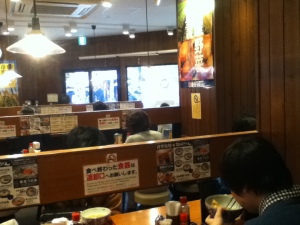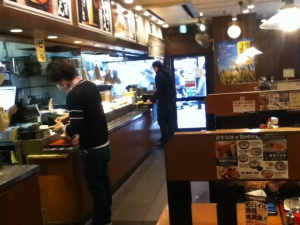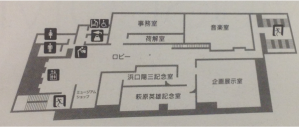Restaurant: Ramen Shop
*My pictures didn’t want to transfer over and I couldn’t find them on my computer!
I decided to write about a ramen shop in Kichijoji, because it was delicious and I’ve gone there multiple times. I always went with friends, but the first time was in a big group and the second in a smaller one. While we pretended to know what was going on the first time, the second time we knew what to do. It was an interesting system that they had set up. You put money in a machine and chose which ramen you wanted. After that, you gave a ticket that came from the machine to a worker. So, in this system, no money was exchanged between the employees and the guest. Also, when we went both times there were only two main people working- one woman and one man. The woman would take the orders and tell the chef, get guests water, clean the table, and help with some cooking. The man cooked behind the table-bar thing (see first picture). The first time we went however, there was one other man cooking in a different part of the kitchen but I couldn’t tell what he was doing.
It was interesting, because we all ate pretty fast, but we were still beaten by most of the others in the shop. For example, a few times business men would come in the shop after us and finish eating before we were close to being done. We definitely stood out in this way, but we also stood out because it was a tiny shop full of all Japanese people. We were the only foreigners both times I went. I also think the woman working recognized us because we were so different from the rest of the usual customers. However, once we had ordered and sat down, we blended in to the shop just like everybody else. I found it hard to make slurpy noises because I’ve been taught that that is rude, but here, you’re supposed to. So I would almost fake making noises because everyone else was slurping so loud. It was also difficult because the noodles were so hot, but it was definitely worth it. Also, I loveeee their eggs! Mmmm!
Museum: Third Trip
We went back to the Kichijoji Art Museum but talked through the art this time. It was a bit unfortunate this time though because there were not many people at the art exhibit. This time there were only older people, mostly men, who were reading through the different explanations of the art work. We talked a lot about why we liked certain artworks more than others and which exhibits were our favorites. In the end, we liked one exhibit the most, but then had random pictures throughout that we each liked. Some of the art was very simplistic, but it was interesting to see how un-simplistic it could be to make that artwork. For instance, the vase print I mentioned in my other observation. The different processes were shown and seemed like a lot of work, but the picture was a line and a vase with flowers in it. So, at first glance some of the art could be seen as simple and easily done, but the exhibits and the way they were set up showed that art, no matter what kind, can take a very long time.
Environmental 3: Tray Return
One thing new I noticed about the tray return was the addition of a worker by the belt that brings the trays into the kitchen. Although I noticed him other times, I watched him even closely this last time. It seemed as though people were a little intimidated by his presence, just as I was. He didn’t do anything but stand there, however, everyone slowed down what they were doing to make sure they recycled the correct way. He even told some people how to do it the right way, and in my case, took my bowl off my tray when I forgot to put it in a separate bin. He was not harsh or anything, he was just there as a friendly reminder to make sure that people took time when putting their tray away. It is kind of like the people at St. Olaf who sit by the tray return to make sure you don’t bring food out, but he was standing closer to make the tray-washer’s job a lot easier.


